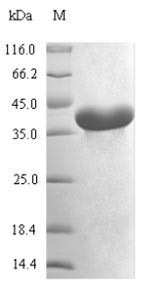Recombinant Mycoplasma pneumoniae Methionine aminopeptidase is produced in E. coli and features an N-terminal 6xHis-SUMO tag for improved solubility and purification. The full-length protein spans amino acids 1 to 248 and is provided with a purity greater than 90% as determined by SDS-PAGE analysis. This product is intended for research use only and is not suitable for clinical applications.
Methionine aminopeptidase is an enzyme that removes the N-terminal methionine from nascent proteins—a critical step in protein maturation and function. It appears to play a key role in post-translational modification processes within cells. This protein may be significant in understanding protein processing pathways and can likely serve as an important tool in various biochemical and structural biology studies.
Potential Applications
Note: The applications listed below are based on what we know about this protein's biological functions, published research, and experience from experts in the field. However, we haven't fully tested all of these applications ourselves yet. We'd recommend running some preliminary tests first to make sure they work for your specific research goals.
Mycoplasma pneumoniae Map is a metalloenzyme that requires precise folding, proper active site formation with metal ion coordination (typically cobalt or manganese), and specific tertiary structure for its enzymatic activity in protein maturation. The E. coli expression system is homologous to this bacterial enzyme, which increases the probability of correct folding. However, the large N-terminal 6xHis-SUMO tag (∼15 kDa) may sterically interfere with the protein's active site or oligomerization interfaces. While the homologous bacterial expression system favors proper folding, the probability of correct folding with full enzymatic activity requires experimental validation, particularly regarding metal ion incorporation and catalytic competence.
1. Biochemical Characterization and Enzyme Kinetics Studies
This application carries a significant risk without functional validation. Map enzymatic activity requires precise metal ion coordination and active site formation that may be compromised by the large SUMO tag. If correctly folded and metal-bound (verified through activity assays), the protein may be suitable for kinetic studies. If misfolded/inactive (unverified), kinetic measurements will yield biologically meaningless results. The SUMO tag may sterically interfere with substrate access to the active site.
2. Antibody Development and Immunological Studies
This application is highly suitable as antibody development relies on antigenic sequence recognition rather than functional enzymatic activity. The full-length protein provides comprehensive epitope coverage for generating antibodies against M. pneumoniae Map. The high purity (>90%) ensures minimal contamination-related issues during immunization protocols.
3. Protein-Protein Interaction Studies
This application requires proper folding validation. Map interactions with other proteins require native conformation. If correctly folded (verified), the protein may identify physiological interaction partners. If misfolded/unverified, there is a high risk of non-specific binding or failure to replicate genuine protein interactions in bacterial metabolic pathways.
4. Structural Biology and Biophysical Analysis
These studies are essential for determining folding status. Techniques should include circular dichroism spectroscopy to assess secondary structure, size-exclusion chromatography to evaluate oligomeric state, and metal content analysis. However, the large SUMO tag may interfere with crystallization for high-resolution structural studies and dominate the protein's biophysical properties.
5. Drug Discovery and Inhibitor Screening
This application carries a high risk without functional validation. Inhibitor screening requires native enzyme conformation and proper metal ion binding. If correctly folded and active (verified), limited screening may be possible. If misfolded/inactive (unverified), screening results will be unreliable for drug discovery due to potential false positives/negatives from altered active site geometry.
Final Recommendation & Action Plan
The E. coli expression system with a large SUMO tag poses challenges for producing a functionally active methionine aminopeptidase, despite the homologous bacterial origin. Begin with Application 4 (Structural Characterization) to assess folding quality through CD spectroscopy, SEC, and validate enzymatic activity using standard methionine aminopeptidase substrates with appropriate metal ion supplementation. Applications 1, 3, and 5 require rigorous functional validation before proceeding. Application 2 (antibody development) can proceed immediately. Consider metal ion supplementation during expression and purification, and evaluate SUMO tag removal for critical functional studies. Always include appropriate activity controls and validate key findings with tag-free protein when possible.






